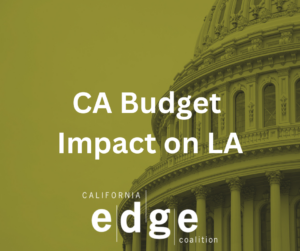 The 2024-2025 State Budget, signed by Governor Newsom on June 29th, has significant implications for Los Angeles County. The budget includes total expenditures of $297.9 billion, with $211.5 billion allocated from the General Fund. This agreement addresses a $46.8 billion deficit for the budget year through a mix of broad-based solutions, including cuts, delays, and reapportionments. This brief examines how the priorities of EDGE in the adopted state budget affect LA County and its residents.
The 2024-2025 State Budget, signed by Governor Newsom on June 29th, has significant implications for Los Angeles County. The budget includes total expenditures of $297.9 billion, with $211.5 billion allocated from the General Fund. This agreement addresses a $46.8 billion deficit for the budget year through a mix of broad-based solutions, including cuts, delays, and reapportionments. This brief examines how the priorities of EDGE in the adopted state budget affect LA County and its residents.
With a population upwards of 9.5 million, LA County often receives a significant portion of the state budget. LA County is home to one of the largest workforce networks, as well as one of the largest education systems in the nation – with seven workforce development boards and 21 community colleges, respectively. Hundreds of labor unions and adult education providers in the jurisdiction also rely on the state budget to fund programs that educate learners, improve job quality, and advance equity. Although the specific allocation for LA County may fluctuate each year, it’s important to acknowledge that advocates focused on Los Angeles can make significant contributions to state budget advocacy efforts.
Education
There is validity for a mixed reaction to the postsecondary education budget outlay regarding LA County. Los Angeles Community College District is one of the largest community college districts in the nation. While the budget preservation of core funding for community colleges continues standard educational operations to educate students, a delay to Cal Grant Reform means that the 19 community colleges in the Los Angeles area will need to find creative solutions to support the 205,000 students pursuing higher education. Without funding, Cal Grant expansion and eligibility to students from low- and middle-income families takes an unfortunate pause.
Investment in postsecondary education includes a $20 million allocation for college campus financial aid offices to continue to support students navigating the financial aid process. The nine financial aid offices serving the greater Los Angeles area will greatly benefit from the support to fund outreach and training efforts.
The enacted budget introduces a statewide lease revenue bond program to fund the construction of 13 affordable student housing facilities at community colleges, including notable projects at Cerritos College and Compton College.
Workforce Development
Workforce training programs, apprenticeships, and career pathway models in Los Angeles are a critical component of the county’s broader workforce development strategy, helping to ensure that all residents have access to economic opportunity.
Any resource reduction for efforts to build a resilient, equitable, and sustainable regional economy, such as the cuts to California Jobs First, the Apprenticeship Innovation Fund, or other workforce initiatives will exacerbate challenges that workers already face while seeking to upskill and train. Cuts will equate to continued shortages of a trained workforce. These cuts could also affect nearly 100,000 healthcare workers in hospitals, clinics, and long-term care facilities in the greater Los Angeles area. No new funding for the Breaking Barriers to Employment Initiative corresponds to a missed opportunity of an average award of $473,000 allocation dedicated to the Los Angeles Basin for career education and training through the Workforce Development Board. Various Los Angeles-based organizations received funding from this state grant in 2022, including Npower and Unite-LA.
Social Safety Net
Social safety nets are crucial to ensure basic needs are met so individuals can complete education and training programs. Approximately 300,000 residents in LA County are benefiting from CalWORKs, a public assistance program that provides cash aid and services to eligible families with children who need immediate financial support. The program also offers employment services, childcare, and other resources to help families achieve self-sufficiency. The limited term cut to CalWORKs Mental Health and Substance Abuse Services Program is to more closely align funds to actual utilization in the program and avoid adverse impacts for LA County parents and families served.
A rejection of the proposed cut of $126 million means that approximately 1.5 million residents in LA County will still benefit from CalFresh, California’s Supplemental Nutrition Assistance Program, which provides eligible low-income individuals and families with financial assistance to purchase nutritious food, helping to alleviate food insecurity. This program is particularly crucial for underserved populations, including families with children, seniors, and individuals facing economic challenges.
The budget maintains funding to expand Medi-Cal eligibility to undocumented immigrants ages 26-49.
To learn more, view EDGE’s full summary of the Governor’s 2024-2025 Enacted State Budget.
For questions, please contact Jason Henderson, Policy Analyst, at jhenderson@caedge.org.
